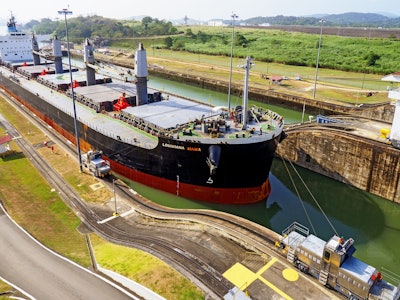
The recent U.S. Department of Agriculture (USDA), Agricultural Marketing Service (AMS) Grain Transportation Report highlights various developments have taken place to enhance the grain handling capacity and transportation systems. These initiatives aim to optimize grain transportation, improve storage capabilities, and support the agricultural sector's evolving needs.
Panama canal enhances vessel transits
The Panama Canal Authority (PCA) is taking steps to address the challenges posed by low water levels in Gatun Lake, which have impacted vessel transits. Starting from January 16, 2024, the PCA will increase the number of daily vessel transits to 24, up from the current 22 transits. This decision comes as a result of greater than expected rainfall in November and the successful implementation of water-saving measures by the PCA.
The previous plan to reduce daily transits to 18 vessels per day by February 1, 2024, has been revoked due to the improved water levels. The Panama Canal restrictions have affected various vessel types, with bulk vessels carrying grain being particularly impacted. These vessels face more challenges in obtaining transit slots compared to cruise ships, container vessels, and LNG tankers due to higher tolls and more precise arrival time requirements.
It is worth noting that the Panama Canal's maximum sustainable number of transits per day during a normal year ranges from 38 to 40. The increased vessel transits will not only benefit grain transportation but also support the smooth flow of other goods and commodities through this vital international waterway.
Landus' upgraded grain handling facility in Boone, IA
To meet the growing demand for grain storage and handling, Landus is undertaking significant upgrades at its Boone, Iowa facility. These enhancements will improve the grain handling capacity and support area growers in storing their harvests effectively.
The planned upgrades include the construction of two new grain bins, adding an additional 3 million bushels of storage capacity. This expansion will enable Landus to accommodate more grain and meet the needs of its customers. Additionally, the facility will be equipped with a new 7,000 bushels/hour dryer, increasing the total onsite drying capacity to 15,000 bushels/hour. This improvement will expedite the drying process, ensuring the timely processing of harvested grain.
Another crucial addition to the Boone facility is a new 30,000 bushels/hour leg and receiving pit, which will enhance the efficiency of grain intake and transportation within the facility. These upgrades signify Landus' commitment to supporting the agricultural community by providing state-of-the-art infrastructure and storage solutions.
The construction of the grain handling upgrades is set to commence in the upcoming spring, with the goal of becoming fully operational before the harvest season of 2024. These enhancements, coupled with Landus' investments in fertilizer and chemical manufacturing facilities, will contribute to the comprehensive support of growers in central Iowa and beyond.
RAISE grants for transportation projects
The U.S. Department of Transportation (DOT) has recently announced the availability of $1.5 billion in grant funding through the Rebuilding American Infrastructure with Sustainability and Equity (RAISE) discretionary grant program for 2024. The RAISE program aims to support transportation projects with significant local or regional impacts, aiding communities across the country in realizing their infrastructure goals.
The RAISE grants are accessible to project sponsors at the state and local levels, including municipalities, tribal governments, counties, and other entities involved in critical freight and passenger transportation infrastructure projects. The eligibility criteria for RAISE grants provide opportunities for funding projects that may face challenges in obtaining support through other DOT grant programs.
The previous year witnessed the successful execution of several projects funded by the RAISE program. For instance, a grade separation project in Chula Vista, California, received funding, enhancing transportation efficiency and safety in the area. Additionally, a new downtown transit center in New Orleans and the reconstruction of Route 6 on the Standing Rock Indian Reservation in South Dakota were among the projects that benefited from RAISE grants.
The DOT encourages applicants to consider the broader implications of their projects, including addressing climate change, promoting racial equity, and removing barriers to opportunity. The RAISE program also emphasizes the importance of lowering costs for households, fostering wealth creation, generating high-paying jobs, and supporting labor standards and training programs.
The application deadline for the 2024 RAISE grants is February 28, 2024. By providing financial assistance and fostering collaboration between stakeholders, the RAISE program will contribute to the development of sustainable and equitable transportation infrastructure across the United States.
Iowa's extension of harvest-time suspension on overweight limits
Recognizing the heavy traffic volumes generated by agricultural trucks during the harvest season, Iowa has extended the suspension of normal limits on overweight loads for transporting grain, fertilizer, and manure. The proclamation, effective until January 14, 2024, enables vehicles to transport overweight loads without a permit while transporting agricultural commodities such as corn, soybeans, hay, straw, silage, stover, fertilizer (dry, liquid, and gas), and manure (dry and liquid).
This extension aims to facilitate the smooth movement of agricultural products throughout the state. The suspension applies to agricultural loads transported on all Iowa highways, except interstates, and applies to loads less than 90,000 pounds gross weight that comply with both the state's maximum axle weight limits and the federal law's maximum axle weight limit of 20,000 pounds.
While this temporary suspension eases the regulatory burden on agricultural trucking, vehicles with overweight loads are still required to adhere to posted weight limits on roads and bridges. By providing this flexibility, the state of Iowa supports the efficient transportation of agricultural commodities, ensuring a successful harvest season for farmers and contributing to the overall growth of the agricultural sector.


















